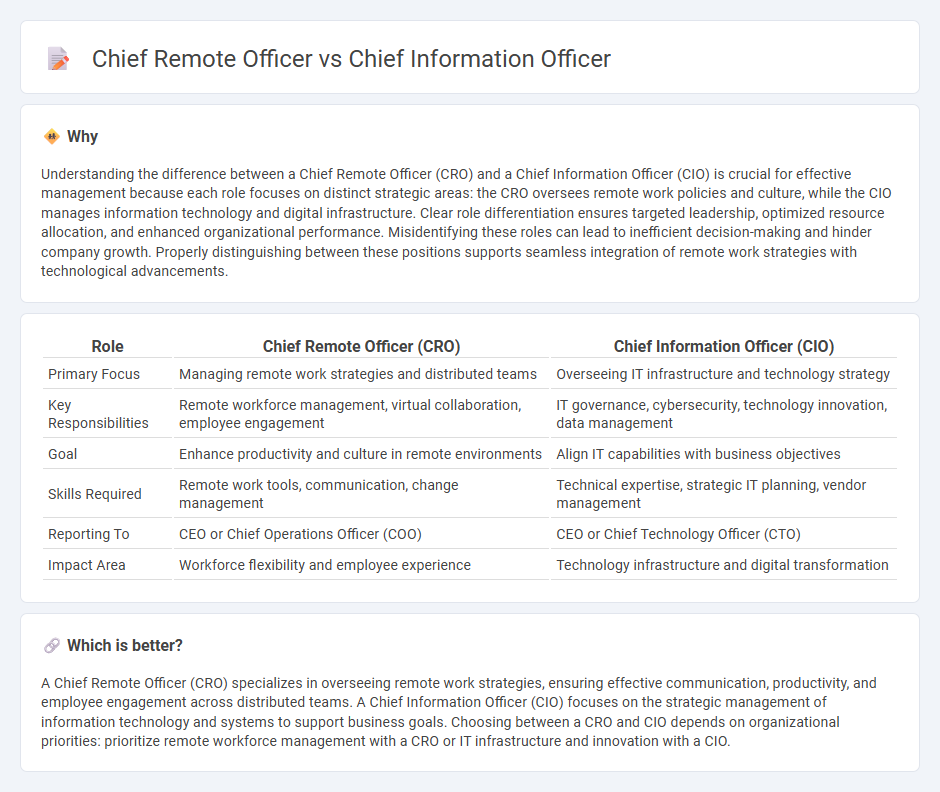
The Chief Remote Officer (CRO) specializes in overseeing remote workforce strategies, ensuring seamless virtual collaboration, and optimizing distributed team productivity, while the Chief Information Officer (CIO) focuses on managing an organization's IT infrastructure, digital innovation, and data security. Both roles play pivotal parts in driving digital transformation but address distinct operational priorities within modern enterprises. Explore in-depth how the CRO and CIO roles intersect and differ in advancing organizational success.
Why it is important
Understanding the difference between a Chief Remote Officer (CRO) and a Chief Information Officer (CIO) is crucial for effective management because each role focuses on distinct strategic areas: the CRO oversees remote work policies and culture, while the CIO manages information technology and digital infrastructure. Clear role differentiation ensures targeted leadership, optimized resource allocation, and enhanced organizational performance. Misidentifying these roles can lead to inefficient decision-making and hinder company growth. Properly distinguishing between these positions supports seamless integration of remote work strategies with technological advancements.
Comparison Table
| Role | Chief Remote Officer (CRO) | Chief Information Officer (CIO) |
|---|---|---|
| Primary Focus | Managing remote work strategies and distributed teams | Overseeing IT infrastructure and technology strategy |
| Key Responsibilities | Remote workforce management, virtual collaboration, employee engagement | IT governance, cybersecurity, technology innovation, data management |
| Goal | Enhance productivity and culture in remote environments | Align IT capabilities with business objectives |
| Skills Required | Remote work tools, communication, change management | Technical expertise, strategic IT planning, vendor management |
| Reporting To | CEO or Chief Operations Officer (COO) | CEO or Chief Technology Officer (CTO) |
| Impact Area | Workforce flexibility and employee experience | Technology infrastructure and digital transformation |
Which is better?
A Chief Remote Officer (CRO) specializes in overseeing remote work strategies, ensuring effective communication, productivity, and employee engagement across distributed teams. A Chief Information Officer (CIO) focuses on the strategic management of information technology and systems to support business goals. Choosing between a CRO and CIO depends on organizational priorities: prioritize remote workforce management with a CRO or IT infrastructure and innovation with a CIO.
Connection
The Chief Remote Officer (CRO) and Chief Information Officer (CIO) collaborate closely to integrate remote work technology with overall IT infrastructure, ensuring seamless digital communication and data security. The CRO focuses on strategies that enhance remote workforce productivity, while the CIO manages the technological resources that support these initiatives. Their partnership drives efficient, secure remote operations and aligns technology deployment with organizational goals.
Key Terms
IT Strategy
The Chief Information Officer (CIO) primarily drives IT strategy, overseeing technology infrastructure, data management, and cybersecurity to align with overall business goals. In contrast, the Chief Remote Officer (CRO) focuses on remote work policies, digital collaboration tools, and employee engagement in distributed teams, ensuring seamless IT support for a remote workforce. Explore in-depth comparisons to understand how these roles shape organizational success in the digital age.
Remote Work Policy
The Chief Information Officer (CIO) primarily oversees technology infrastructure and data management to support remote work, ensuring secure and efficient digital operations. In contrast, the Chief Remote Officer (CRO) focuses on developing and implementing remote work policies, employee engagement, and maintaining productivity in distributed teams. Explore the distinct roles of CIO and CRO to optimize your organization's remote work strategy effectively.
Digital Transformation
The Chief Information Officer (CIO) spearheads digital transformation by integrating advanced technologies and optimizing IT infrastructure to drive business innovation and efficiency. In contrast, the Chief Remote Officer (CRO) focuses on managing and enhancing remote work strategies, ensuring seamless digital collaboration and workforce flexibility in a distributed environment. Explore how these roles uniquely contribute to digital transformation and organizational success.
Source and External Links
chief information officer - Glossary | CSRC - A Chief Information Officer (CIO) is an agency official responsible for advising senior management on acquiring and managing information technology and resources in compliance with laws and policies, developing and implementing IT architecture, and promoting efficient information resource management processes.
Chief information officer - The CIO is a business leader who makes executive decisions on IT procurement and system creation, leads the workforce, develops IT strategy and policy, and increasingly manages customer-facing digital services.
How to Become a CIO - CIOs are executives who oversee a company's technological infrastructure to ensure it supports business goals, manage IT departments, lead IT projects, and collaborate with other executives for strategic alignment.
 dowidth.com
dowidth.com